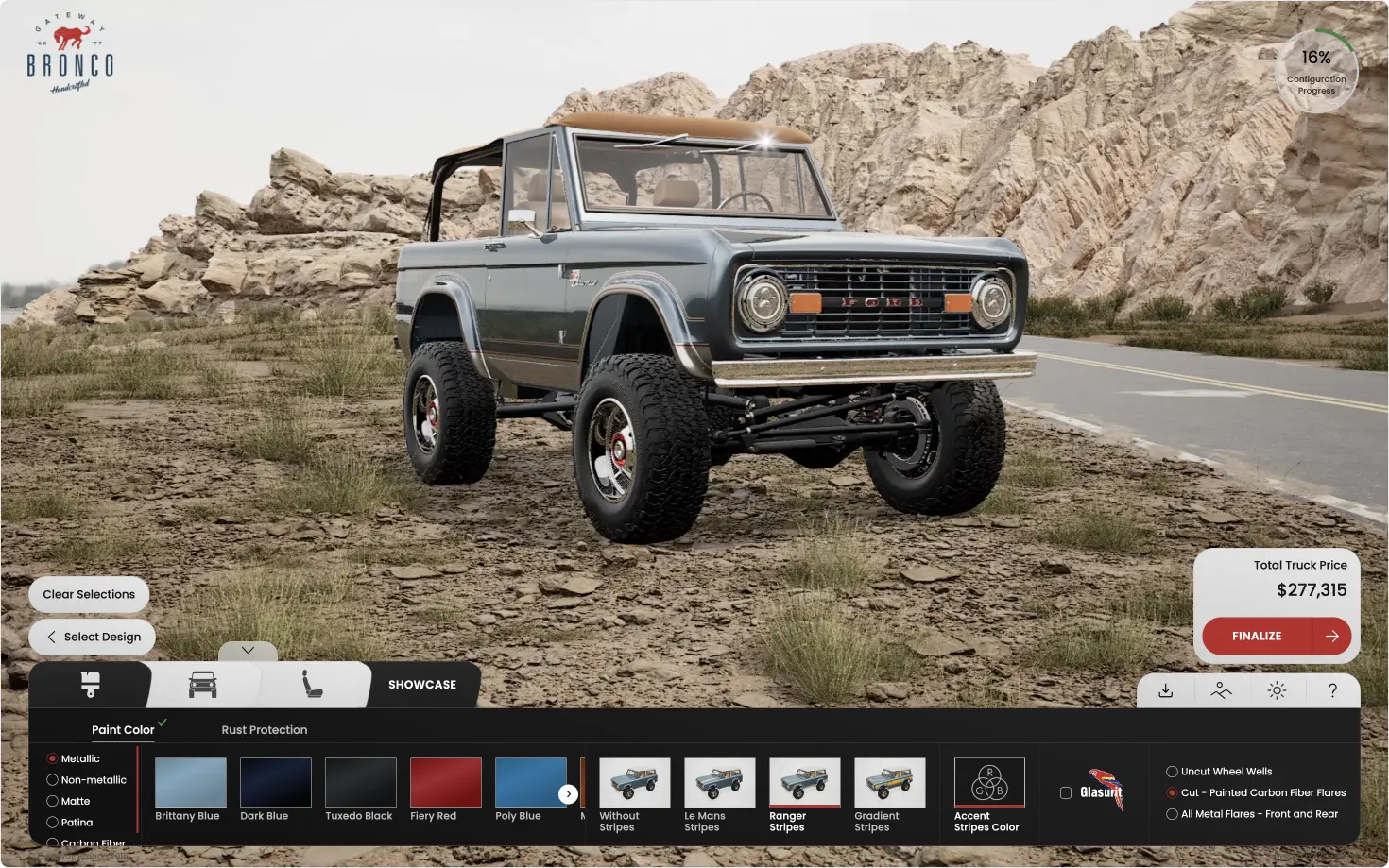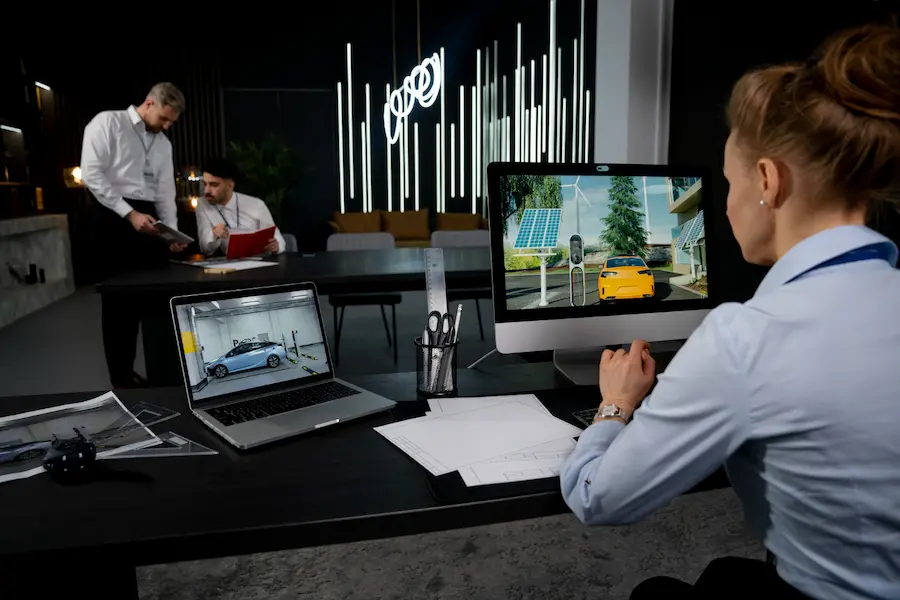Offering personalized experiences is crucial for businesses looking to engage customers effectively. Although immensely powerful tools, few people know how to build optimized product configurators. These tools allow customers to visualize and customize products in real-time. According to a recent study, 80% of business leaders polled said that personalized experiences led to visibly increased consumer spending. Having a 3D product configurator on your ecommerce site is a great way to make the user experience better, and raise conversion rates.
Building a 3D product configurator can be broken down into essential steps that guide the development process. From defining the product features to deploying the tool, we will cover each stage to help you create a user-friendly, scalable configurator.
Key takeaways
-
A 3D product configurator provides real-time customization options that increase customer engagement, and creates a more personal experience.
-
Properly defining changeable product features is key to creating an intuitive, efficient configurator.
-
Choosing the right 3D engine ensures smooth visuals and improves performance.
-
Strong product logic prevents invalid combinations and enhances the user experience.
-
A simple, responsive user interface improves customer interaction and satisfaction.
-
Continuous testing and optimization across platforms are necessary for consistent performance.
Six key steps to build a 3D product configurator
Building a 3D product configurator requires a systematic approach to ensure it meets user expectations and operational needs. Below are the critical steps involved.
-
Define your product’s features
The first step is to identify the core features of the product that customers will want to customize. For instance, for a sofa, users may want to choose between materials, colors, and dimensions, as well as add-ons like extensions and additional cushions. For vehicles, they might select different paint finishes, interiors, and vanity or performance-focused tires and rims.
Having a well-defined product scope ensures the configurator offers relevant and clear options. Additionally, the configurator should be malleable enough to quickly accommodate future product line expansions. This forward-thinking approach saves time and resources down the line.
-
Choose a 3D engine
The 3D engine you select will have a significant impact on the visual quality and overall performance of the configurator. Engines like Unity and Unreal Engine both offer varying levels of rendering power and customization features. Unity and Unreal Engine are widely known for their advanced capabilities in real-time rendering, but they may require more expertise to use effectively.
Choosing the right engine depends on your product complexity and the user experience you aim to deliver. It's essential to weigh performance requirements and ease of use when making this decision.
-
Create 3D models
Next, high-quality 3D models must be developed to accurately represent your product. Whether it's furniture, vehicles, or other customizable goods, the models should offer precise details and reflect real-world dimensions. Use software like Blender, Maya, or 3Ds Max to create models that are best optimized for real time rendering.

These models need to be efficient to ensure fast loading times and seamless interactivity, especially if your configurator is meant to run on multiple platforms, such as desktops and mobile devices. If in-house resources aren't available, consider outsourcing the modeling work or using pre-built assets.
-
Implement product logic
This step involves coding the rules that dictate how the configurator functions. Product logic governs how different customization options interact. For example, in a furniture configurator, selecting a specific fabric might limit the choice of colors or styles. Ensuring these combinations are valid enhances the user experience and prevents confusion.
Programming languages like JavaScript, C#, or Python are most often used to set these rules. Logic also needs to account for real-time updates to the 3D model based on user selections, ensuring a smooth, interactive experience.
-
Design the user interface
A 3D configurator is only as good as its user interface. The interface should be simple, user friendly, and responsive, and should lead users through the product customization process seamlessly. The best configurators employ a combination of dropdown menus, sliders, and buttons to guide users in making their selections.
A well-designed interface improves the configurator’s usability, ensuring that users can make decisions quickly and without frustration. It should be visually appealing but not overwhelming, with real time feedback on changes. It’s recommended to use languages like HTML, CSS, and JavaScript in order to build a responsive and interactive UI that functions properly across different devices and aspect ratios.
-
Testing and deployment
After building the configurator, extensive testing is essential to ensure its functionality across different platforms and devices. It’s important to test the configurator for speed, memory usage, and performance on various browsers. Testing should also include scenarios such as high traffic to ensure that the configurator performs reliably under different conditions.
Once testing is complete, the configurator can be deployed on your website or eCommerce platform. Continued optimization and updates will keep the tool functioning smoothly and enhance the overall user experience.
Key features of a 3D product configurator
To ensure a smooth and engaging user experience, a 3D product configurator for an ecommerce site should come with specific features designed to enhance customization and ease of use.
-
Real-time rendering allows customers to see their changes immediately, providing instant feedback as they customize their products. This feature ensures that users can experiment with different configurations without delay, making the experience more engaging and interactive.
-
Providing a breadth of customization options is essential for a good 3D product configurator. This could include color choices, material types, sizes, and various add-ons. The more flexibility you provide, the more likely users are to find a configuration that suits their needs.
-
Integrating augmented reality (AR) into a configurator is another way to elevate the customer experience. Augmented reality allows users to virtually project their creations into their own physical spaces on their smartphones or tablets, making it easier to visualize the final product. Augmented reality is particularly useful for furniture and home goods, where users can see how an item fits in their home before making a purchase.

-
A robust 3D configurator includes built-in analytics that track customer preferences and behavior. This data is invaluable for businesses as it provides insights into popular configurations, user behavior, and potential areas for improvement. These reports can help guide inventory decisions and future product development.
-
Allowing customers to share their personalized products on social media can increase visibility and drive new customer engagement. This feature also adds an element of social proof, showcasing real-world examples of customized products to potential buyers.
Real-life examples of a 3D product configurator
It can be difficult to imagine how a 3D product configurator functions. Here are examples of projects 3D Source has made for some of the clients.
Bathroom design

3D Source has developed a 3D bathroom configurator that offers highly realistic and interactive visualizations of bathroom layouts. This configurator allows users to easily customize various aspects of the room, from selecting specific bathtubs and showers to modifying wall colors, sinks, and flooring. With this tool, customers can experiment with different configurations and designs, ensuring the bathroom meets their individual preferences and requirements without any commitment, as well as better visualize how their potential purchases will match their current bathroom layout.
Vehicle configurator

Following the bathroom design tool, 3D Source developed a vehicle configurator that allows users to fully customize their ideal car. Customers can select from various models, exterior paint colors, interior materials, wheel designs, and can even change the rendering’s background, to fully imagine your prospective vehicle. The configurator provides a real-time preview of their choices, helping users visualize the final look and feel of their customized vehicle. This tool offers a detailed, hands-on experience that aids in decision-making and ensures customer satisfaction before purchasing.
Conclusion
Building a 3D product configurator for an ecommerce site is a detailed process that can greatly enhance the customer experience and increase sales. From defining product features to selecting the right engine, each step is essential for creating an interactive, user-friendly tool. Advanced features like real-time rendering and analytics further improve the configurator’s value, offering insights into customer preferences and helping refine your product offerings.
If you're looking to create a 3D configurator that meets your specific needs, 3D Source is here to help build the right configurator for your business.







